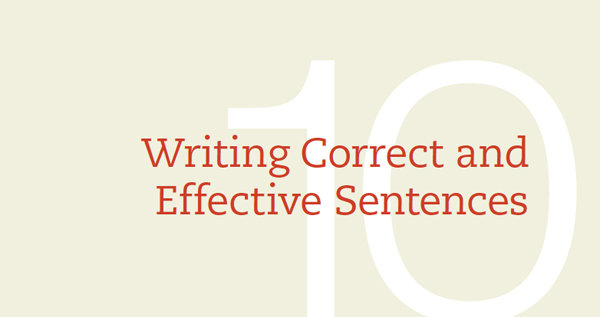10 Writing Correct and Effective Sentences
Printed Page 215-216

Writing Grammatically Correct Sentences
AVOID SENTENCE FRAGMENTS
AVOID COMMA SPLICES
AVOID RUN-ON SENTENCES
AVOID AMBIGUOUS PRONOUN REFERENCES
COMPARE ITEMS CLEARLY
USE ADJECTIVES CLEARLY
MAINTAIN SUBJECT-VERB AGREEMENT
MAINTAIN PRONOUN-ANTECEDENT AGREEMENT
USE TENSES CORRECTLY
Structuring Effective Sentences
EMPHASIZE NEW AND IMPORTANT INFORMATION
CHOOSE AN APPROPRIATE SENTENCE LENGTH
FOCUS ON THE “REAL” SUBJECT
FOCUS ON THE “REAL” VERB
USE PARALLEL STRUCTURE
USE MODIFIERS EFFECTIVELY
Choosing the Right Words and Phrases
SELECT AN APPROPRIATE LEVEL OF FORMALITY
BE CLEAR AND SPECIFIC
• ETHICS NOTE: Euphemisms and Truth Telling
BE CONCISE
• DOCUMENT ANALYSIS ACTIVITY: Revising for Conciseness and Simplicity
USE INOFFENSIVE LANGUAGE
• GUIDELINES: Avoiding Sexist Language
• GUIDELINES: Using the People-First Approach
Understanding Simplified English for Nonnative Speakers
Preparing Text for Translation
WRITER’S CHECKLIST
EXERCISES
LEARNINGCURVE: Writing Correct and Effective Sentences and 
CASE 10: Revising a Document for Nonnative Speakers and for Translation and 
In the workplace, it’s important to choose words carefully and write accurate, clear, concise, correct, and forceful sentences. If a sentence doesn’t say what you intended, misunderstandings can occur, and misunderstandings cost money. More important, the ability to write well—word by word and sentence by sentence—reflects positively on you and your organization. If you write well, you sound like a professional; you sound like someone worth reading.